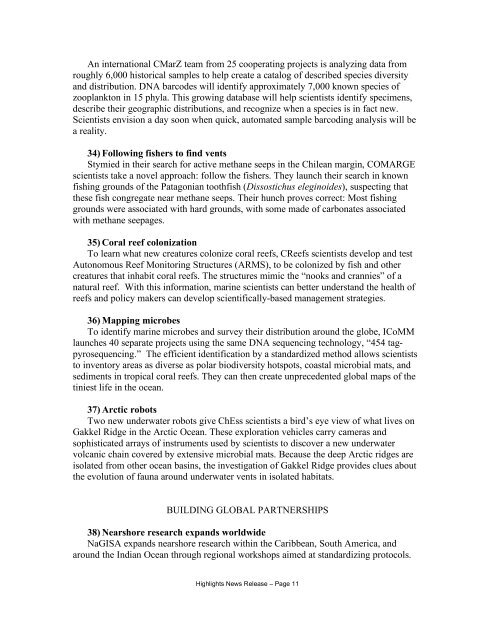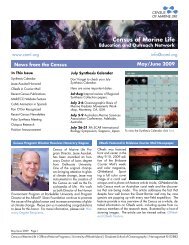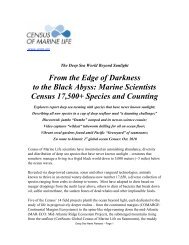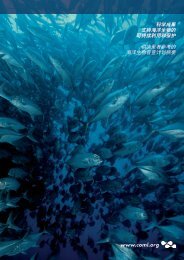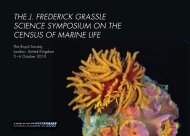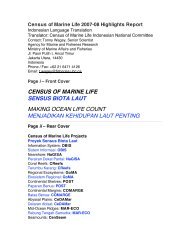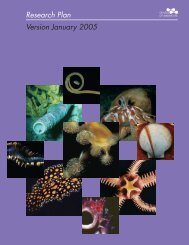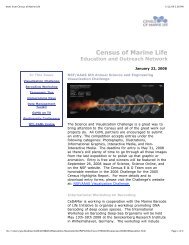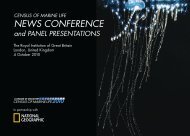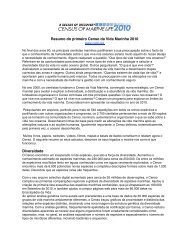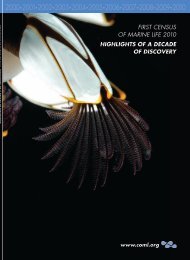Full press release - Census of Marine Life
Full press release - Census of Marine Life
Full press release - Census of Marine Life
Create successful ePaper yourself
Turn your PDF publications into a flip-book with our unique Google optimized e-Paper software.
An international CMarZ team from 25 cooperating projects is analyzing data fromroughly 6,000 historical samples to help create a catalog <strong>of</strong> described species diversityand distribution. DNA barcodes will identify approximately 7,000 known species <strong>of</strong>zooplankton in 15 phyla. This growing database will help scientists identify specimens,describe their geographic distributions, and recognize when a species is in fact new.Scientists envision a day soon when quick, automated sample barcoding analysis will bea reality.34) Following fishers to find ventsStymied in their search for active methane seeps in the Chilean margin, COMARGEscientists take a novel approach: follow the fishers. They launch their search in knownfishing grounds <strong>of</strong> the Patagonian toothfish (Dissostichus eleginoides), suspecting thatthese fish congregate near methane seeps. Their hunch proves correct: Most fishinggrounds were associated with hard grounds, with some made <strong>of</strong> carbonates associatedwith methane seepages.35) Coral reef colonizationTo learn what new creatures colonize coral reefs, CReefs scientists develop and testAutonomous Reef Monitoring Structures (ARMS), to be colonized by fish and othercreatures that inhabit coral reefs. The structures mimic the “nooks and crannies” <strong>of</strong> anatural reef. With this information, marine scientists can better understand the health <strong>of</strong>reefs and policy makers can develop scientifically-based management strategies.36) Mapping microbesTo identify marine microbes and survey their distribution around the globe, ICoMMlaunches 40 separate projects using the same DNA sequencing technology, “454 tagpyrosequencing.”The efficient identification by a standardized method allows scientiststo inventory areas as diverse as polar biodiversity hotspots, coastal microbial mats, andsediments in tropical coral reefs. They can then create unprecedented global maps <strong>of</strong> thetiniest life in the ocean.37) Arctic robotsTwo new underwater robots give ChEss scientists a bird’s eye view <strong>of</strong> what lives onGakkel Ridge in the Arctic Ocean. These exploration vehicles carry cameras andsophisticated arrays <strong>of</strong> instruments used by scientists to discover a new underwatervolcanic chain covered by extensive microbial mats. Because the deep Arctic ridges areisolated from other ocean basins, the investigation <strong>of</strong> Gakkel Ridge provides clues aboutthe evolution <strong>of</strong> fauna around underwater vents in isolated habitats.BUILDING GLOBAL PARTNERSHIPS38) Nearshore research expands worldwideNaGISA expands nearshore research within the Caribbean, South America, andaround the Indian Ocean through regional workshops aimed at standardizing protocols.Highlights News Release – Page 11


